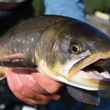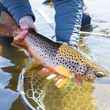I've been interested in Tenkara rods since they were first introduced to me many years ago. Given that I spend a healthy number of my fishing days each year backpacking into small, densely forested brook trout streams here in the eastern U.S., Tenkara has often seemed like the ideal tool for these streams where short, controlled casts in tight quarters are what is required to lure eager brook trout to the fly. Given my interest and the amount of time I spend in such Tenkara-friendly fishing interest, imagine how unlikely it was to turn out that my first experience with a Tenkara rod would be on an Alaskan river with pink salmon as my quarry.
If you're not already familiar with Tenkara, it is a traditional Japanese method of fly-fishing, which uses only a rod, line and fly. No reels. The rods range in length from 11' to almost 14', but are telescopic. They pack down to around a foot and a half in length, making them ideal for backpacking. And, the fly line isn't the standard fly line you're used to. Tenkara line is more similar to leader material, and you're typically only working with 10 to 15 feet of it.
The whole setup is intended to simplify the process of fly fishing, and it most definitely does that. Many consider it the ideal system for fishing small mountain streams such as the aforementioned brook trout streams. In addition to the packability and simplicity, which are big plusses when backpacking into small waters, Tenkara offers a number of advantages once the fishing begins. Examples include controlling line in tight quarters by using the rod to place and control a fly carefully as well as the ability to make very delicate presentations due to the dramatically lighter line (as compared to traditional fly lines). And, while Tenkara is best known for pursuing smaller fish, the rods aren't afraid to tackle bigger fish. A 16" trout will come in easily on a Tenkara rod, and will be a blast to play.
If you haven't already guessed, though, Tenkara rods aren't exactly intended for Alaskan salmon. But, when you're on the last day of an Alaskan fishing trip where you've been catching Alaskan pink salmon on every third cast for days on end, and the Tenkara USA rods you've been waiting to try on more reasonable quarry -- such as the 12-25" dolly varden we had pursued in days prior, and for which the Tenkara rods would have been an excellent, if not ideal, tool -- have just arrived, what do you do? You tie on a pink streamer and try to hook up a pink salmon, that's what you do.

And hook up a pink salmon we did, as well as an awful looking chum salmon that was every bit of 10 pounds. Somewhat to everyone's surprise, the Tenkara rods performed. Sure, we lost one to a particularly beefy dolly, but the two rods that hooked up salmon emerged unscathed. After an extended fight, the chum eventually wrangled loose, but the pink (seen above) came to hand.
Admittedly atypical and possibly a bit stupid, my introduction to Tenkara was entertaining and engaging and will undoubtedly have me headed into the woods this fall with a Tenkara rod stashed in my pack. And, with that ugly chum in the back of my mind, I won't be the least bit concerned if one of my mountain streams turns up an unusually fat brook or brown trout.































Comments
Austin Orr replied on Permalink
Catching large fish on somewhat ridiculously under-gunned equipment? Sounds like a blast to me!
Lynn David replied on Permalink
It would seem similar to the noodle rods that are made to battle salmon and steelhead on light lines, but they have the advantage of letting out line. Rather there are other fixed line rods known as keiryu in Japan which are of a greater back-bone and with the ability of handling larger tippets which would be more suited to a 5+ pound fish.
Pages